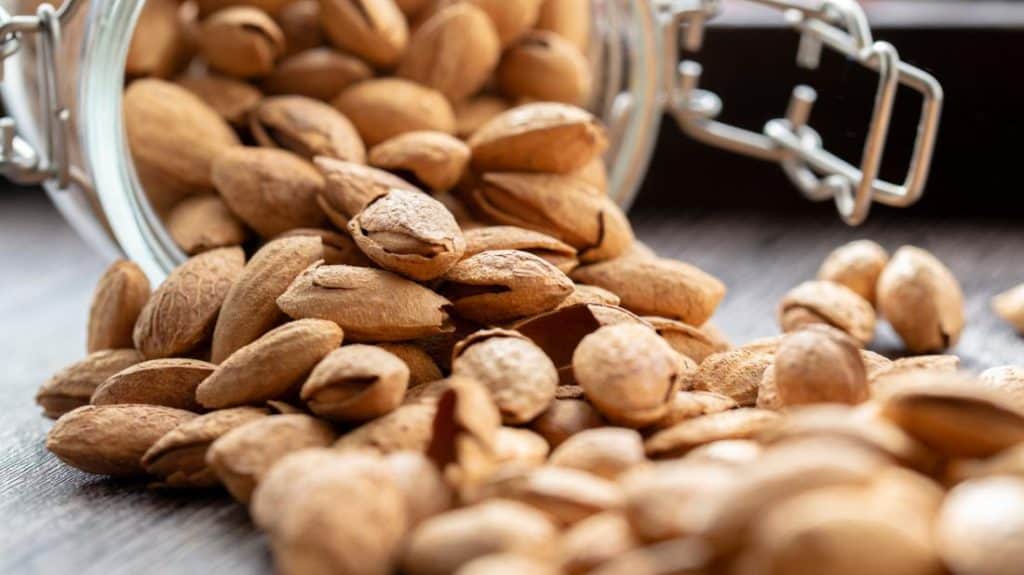Almond also called Badam (Prunus dulcis, syn. Prunus amygdalus) is a species of tree native to Iran and surrounding countries but widely cultivated elsewhere. Badam is also the name of the edible seed of this tree. The almond is a deciduous tree, Almond grows best in Mediterranean climates with dry summers and mild, warm, and wet winters.
The almond fruit, In botanical terms, is not a nut but a drupe. The outer covering, fleshy in other members of Prunus such as the plum and cherry, is instead a thick, leathery, grey-green coat (with a downy exterior), called the hull. Inside the hull is a hard, woody shell (like the outside of a peach pit) called the endocarp. Inside the shell is the digestible seed, commonly called a nut. Generally, one seed is present, but occasionally two occur. After the fruit matures, the hull splits and is set apart from the shell, and an abscission layer forms between the stem and the fruit so that the fruit can fall from the tree.
Nutritional Information of Almonds-
A serving of 1-ounce (oz) (23 nuts), badam contains the following nutritional components.
- Calories: 164
- Protein: 6 grams (g)
- Fat: 14 g
- Saturated fat: 1 g
- Monounsaturated fat: 9 g
- Polyunsaturated fat: 3 g
- Carbohydrates: 6 g
- Fiber: 3.5 g
- Sugars: 1 g
Almonds are high in healthy monounsaturated fats, protein, fiber, and various important nutrients. Badam is among the world’s best sources of vitamin E. Getting Abundant vitamin E from foods provides various health benefits.
Nutritional Importance of Almonds
Almonds, also known as badam in many parts of the world, are a nutritious and delicious type of tree nut that is known for its potential health benefits. Here is what you need to know about the nutritional importance of almonds:
- Almonds are a good source of nutrients: Almonds are a good source of a variety of nutrients, including fiber, protein, and healthy fats. They are also a good source of antioxidants, which are substances that help to protect against oxidative stress and chronic diseases.
- Almonds are a good source of fiber: Almonds are a good source of fiber, with about 3 grams of fiber per ounce (about 23 almonds). Fiber is an important part of a healthy diet as it helps to promote regular bowel movements, lower cholesterol levels, and keep you feeling full and satisfied.
- Almonds are a good source of healthy fats: Almonds are a good source of healthy fats, including monounsaturated and polyunsaturated fats. These types of fats are important for heart health and may help to lower cholesterol levels.
- Almonds are low in calories: One ounce of almonds (about 23 almonds) contains about 164 calories, making them a relatively low-calorie snack.
- Almonds are low in carbohydrates: Almonds are also low in carbohydrates, with about 6 grams of carbs per ounce. This makes them a good choice for people following a low-carb diet.
Overall, almonds are a nutritious and delicious addition to your diet. They are a good source of a variety of nutrients and are low in calories and carbohydrates.
Glycemic Index Of Almonds
Almonds, also known as badam in many parts of the world, are a nutritious and delicious type of tree nut that are known for their potential health benefits. The glycemic index (GI) of a food is a measure of how quickly it raises blood sugar levels. Here is what you need to know about the glycemic index of almonds:
- Almonds have a low glycemic index: Almonds have a low glycemic index, which means that they are less likely to cause a rapid increase in blood sugar levels compared to foods with a high glycemic index. Foods with a low glycemic index are generally considered to be better for blood sugar control and may be beneficial for people with diabetes or at risk for developing diabetes.
- Almonds may have other health benefits: In addition to having a low glycemic index, almonds are also a good source of nutrients such as fiber, protein, and healthy fats. They are also a good source of antioxidants, which may help to protect against oxidative stress and chronic diseases.
- Almonds should be used in moderation: While almonds have a low glycemic index and may offer some health benefits, it is important to use them in moderation as part of a balanced diet. Like any other food, eating too many almonds can contribute to excess calorie intake and weight gain.
In conclusion, almonds have a low glycemic index and may offer some potential health benefits. However, it is important to use them in moderation and as part of a balanced diet.
Uses of Almonds-
- Almonds are available in many forms, such as whole, sliced (flaked, slivered), and flour. Almond tiny pieces, called “nibs”, are used for special purposes such as decoration. Almonds are used to make almond oil, almond butter, or almond milk. You can use them in both sweet and savory dishes.
- Almonds are also sprinkled over desserts and breakfast meals, particularly muesli or ice cream-based dishes. You can use badam in marzipan, nougat, many pastries, cookies and cakes, and other sweets and desserts. You can also use almonds to prepare almond butter. The young, developing fruit of the almond tree can be eaten whole (green almonds) when they are still green and fleshy on the outside and the inner shell has not yet hardened. You can eat badam with dates also.
- Badam in India – In Indian cuisine, Badam is the base ingredient of Mughlai curries. Badam halwa is a sweet made from almonds. Almond flakes are added to many sweets(such as sohan barfi) and are usually visible sticking to the outer surface. Badam sherbet or sherbet-e-badam is a popular summer drink.
- Almond Milk – Almonds are processed into a milk substitute called almond milk; the nut\’s soft texture, mild flavor, and light coloring (when skinned) make for an efficient analog to dairy and a soy-free choice for lactose intolerant people and vegans. Blanched raw and lightly toasted almonds work well for different production techniques, some of which are similar to that of soymilk and some of which use no heat, resulting in “raw milk”
- Almond flour- You can combine Almond flour or ground almond with sugar or honey as marzipan is often used as a gluten-free alternative to wheat flour in cooking and baking
- Almond oil– Almond oil can be applied to your skin and hair for good benefits as it is rich in vitamin E.
Benefits of Almonds-
-
Rich in Nutrients- Almonds are rich in nutrients. Almonds contain good amounts of fats, plant protein, and fiber. Vitamin E acts as antioxidant protecting cells from damage. Whereas Magnesium helps in boosting brain health, mood, and sleep as well as regulation blood sugar and blood pressure levels.
-
Packed with antioxidants
– Almonds are antioxidant-rich that can protect your cells from oxidative damage, a major contributor to aging and disease. Vitamin E also supports immunity, reduces inflammation, and also helps widen blood vessels to improve blood flow.
-
Good for gut health- Consuming almonds are good for the gut. Both raw and roasted almonds have been found to act as prebiotics, which serves as food for the beneficial bacteria in the gut linked to immunity, anti-inflammation, and mental health.
-
Lowers cholesterol level- almonds are one of the best foods for naturally lowering your cholesterol. Studies show that eating almonds can reduce LDL or “bad” cholesterol levels.
- Helps in regulating blood sugar levels-Nuts are low in carbs but high in healthy fats, protein, and fiber. This makes them a perfect choice for people with diabetes. Another boom is Almonds are extremely high in magnesium, a mineral that many people don’t get enough of. High magnesium intake may offer major improvements for type 2 diabetes.
-
Lowers blood pressure- The magnesium in almonds may additionally help lower blood pressure levels. High blood pressure can lead to stroke or heart attack. Almonds here can help in regulating blood pressure and reduce its risk.
-
Improves heart health- Almonds protect your heart in several ways. Almonds being rich in nutrients and antioxidants promotes good heart health.
-
Reduces risk of cancer– A 2015 study looked at nut consumption and cancer risk. The authors identified a two to three-times lower risk of breast cancer among individuals who consumed higher quantities of peanuts, walnuts, and almonds, compared with those who did not.
-
Aids in weight loss – Almonds are low in carbohydrates but high in protein, healthy fats, and fiber.
-
Good for skin
– Good fats support skin health. Almonds being rich in Vitamin E and other oxidants help in soft and supple skin. You can use almond oil on your skin to see the results.
- Eliminates craving and keeps you full- Almonds are high in plant protein, keeping you full and satisfied all afternoon long. Having almonds as a snack might prevent sugar cravings.
According TO Research,
There’s a good reason for the love affair. “Almonds have been studied extensively for their benefits on heart health, diabetes, and weight management,” said Jenny Heap, a registered dietitian with the Almond Board of California. “The unique nutrient combination of almonds — plant-based protein, fiber, and monounsaturated fats, plus key nutrients like vitamin E and magnesium — help make them a heart-healthy snack.”
A 2017 study published in Nutrition Journal found that Americans, especially children, who replaced snack foods with almonds or other tree nuts saw a major increase in the consumption of nutrients. In the study of more than 17,000 children and adults, participants swapped all their snacks with almonds and. Researchers found that participants consumed fewer empty calories, solid fats, sodium, saturated fats, carbohydrates, and added sugars. Good oils and fats increased significantly, as did magnesium, fiber, and protein by a small margin.
Quick ideas to use almonds aka badam in your daily diet-
Almonds are an easy portable snack as is, but they can also be incorporated into meals. Some of the quick ideas are –
- Add a punch to plain yogurt by mixing in some chopped almonds and dried fruit.
- Enhance a healthy saute of curried vegetables with sliced almonds.
- Add some almond butter to a breakfast shake to boost its taste and protein content.
- Almonds and apple slices make a wonderfully simple, on-the-go power snack.
- Make a delightful cold rice salad with almonds, fresh garden peas, and currants.
- Add sliced almonds to the chicken salad.
- Add almond butter into a smoothie, drizzle it over overnight oats, and use it as a dip for fresh fruit or as the base for energy balls—combined with add-ins like minced dried fruit, chopped dark chocolate, spices, and seeds.
- Coat baked or sautéed fruit with a crumble topping made from almond butter, a touch of maple syrup, rolled oats, and cinnamon.
- Sprinkle almonds onto a salad, cooked veggies, or a stir-fry.
- Use almond flour instead of breadcrumbs to garnish lentil soup, spaghetti squash, or hummus, or in place of all-purpose flour in pancakes and baked goods.
- You can also toss veggies with a savory almond butter sauce made with veggie broth, minced garlic, freshly grated ginger, and crushed red pepper.
Almonds on the keto diet
The goal of a Ketogenic diet is to force your body into using fat for energy instead of carbs. So you need to cut out carbs from your eating habits altogether. Almonds and many other nuts are high in fat while at the same time low in carbs.
Another factor that makes almonds ideal for a Keto diet is their convenience. It is almost impossible to ignore unhealthy snacks such as chips or sodas while stopping at a gas station during a long car ride. These snacks have the potential to ruin your Keto diet. This is where almonds come in. Not only are they unbelievably healthy, but they are as portable as any other snack on the market. You can use them to stay away from unhealthy cravings while keeping your hunger satisfied. Delicious!
Benefits of Almonds On the keto diet
Consider these mighty nuts one of the most versatile ingredients in your keto pantry. “You can enjoy almonds as a snack alone, added into salad or stir-fries, or ground into almond butter as a keto-friendly veggie dip. They’re a good source of fiber, unsaturated fat, calcium, and protein. Almonds are a great source of magnesium and potassium, which are important electrolytes to replenish on a ketogenic diet!
Just be careful not to overdo it. They do contain a small number of carbohydrates, so keeping an eye on portions is important. On the keto diet, you’ll need to restrict your carb intake to about 20 to 50 g of net carbs (generally, carbs minus fiber) per day to stay in ketosis, though your specific macronutrient needs may vary.
Takeaway
To sum up, Consuming a higher amount of fat is important on a keto diet for beginners, and getting a variety of different fats is recommended. As a source of primarily unsaturated (polyunsaturated and monounsaturated) fats, seeds and nuts on a ketogenic diet can be a great choice to include in your daily menu Nuts are nutrient-dense foods.
With so many tasty ways of incorporating almonds into your diet, whether you want to snack on them raw, or use almond butter, milk, or almond flour in your next delicious recipe. Almonds are the most versatile nuts and have various benefits.
Get started with your Weight Loss Journey today and take a step towards a healthy lifestyle! Stay tuned for inspiring Weight Loss Journeys, and Delicious Recipes! Also, don’t forget to follow us on Instagram for the daily dose of Health, and Wellness content!









